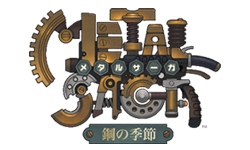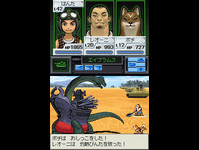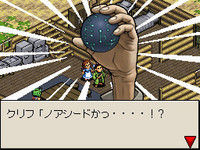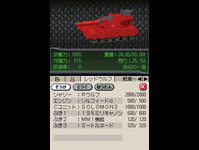|
|

|
PLATFORM
|
DS
|
BATTLE SYSTEM
|

|
INTERACTION
|

|
ORIGINALITY
|

|
STORY
|

|
MUSIC & SOUND
|

|
VISUALS
|

|
CHALLENGE
|
Moderate
|
LANGUAGE BARRIER
|
Moderate
|
COMPLETION TIME
|
40-60 Hours
|
|
OVERALL

|
+ Works well as a direct sequel.
+ The series' soundtrack still rocks.
+ Every town is unique in design.
- Too linear in execution.
- Item management overly clunky.
- Not enough tanks in combat.
|
Click here for scoring definitions
|
|
|
Two centuries ago, the governments of Earth put their trust in technology with the hope of saving a failed environment. This trust was betrayed when the AI in charge of Project NOAH determined that people were the problem. Humanity barely survived the war against its own military and industrial infrastructure.
The results can still be seen throughout Metal Saga: Season of Steel. Technically the fourth game in the Metal Max series, Season of Steel was developed during a period where the series' trademark was under litigation, hence the difference in name. All the same, it is definitely a part of the series proper, being a direct sequel to the original Metal Max. In that game, a band of hunters and mercenaries took out the last stronghold of NOAH. Twenty years later, however, remnants of its army still roam the land. Bizarre experiments run rampant, cybernetic assassins lurk in the ruins, the mutants protest their third-class citizenship, and a vast weapons platform known as Overlord controls the skies.
A lone hunter named Jaycee has traveled far to find the legendary man who defeated NOAH. With him he brings the most dangerous item on the planet, the NOAH Seed. It is his hope that the hero of old may find some way of destroying the Seed before it can be used to create a new NOAH. Unfortunately he arrives a few years too late. Instead, the hero's only son must take up the task of destroying this new generation of NOAH.
From the start, Season of Steel has more story than any of its predecessors, but "more" does not necessarily mean "a lot." Compared to current standards, it's still a bit sparse. In some ways this game's greater focus on story can be seen as detrimental, as the strictures of plot progression have limited the amount of exploration. The world map no longer allows free roaming and instead links major locations together by set paths. There are a few open areas to explore, each offering secrets and multiple exits, but often it's possible to unlock the route to another town and still be unable to go to that town because it hasn't been unlocked by the game's plot. For a series that usually boasts wide exploration and lots of optional areas, this feels restrictive.
 Check out Pochi in the lower right corner. Man, what a little SOB...
Check out Pochi in the lower right corner. Man, what a little SOB...
|
|
The battle system also sees its fair share of give and take. It starts with the series' version of turn-based combat featuring lots of guns, tanks, and explosions, and builds off that. In the plus column, characters learn class-specific skills as they gain experience, and everyone can switch between three equipped weapons freely during combat. It is also possible to load two party members into one vehicle so that more than one piece of heavy artillery can be used at a time.
Unfortunately, Season of Steel falls flat in some other respects. The party size has been reduced to three, with the Hero and Pochi the battle dog filling permanent spots. There are five partner characters who can be switched out at a particular spot, but keeping them equally leveled can be a challenge. To make matters more annoying, one character (the weakest and initially lowest leveled of the bunch) is critical to passing through a difficult part of the final level, but getting him through the entire ordeal alive requires a lot of work.
Each piece of tank equipment in Season of Steel has its own stats. This includes defense, hit points, and specific weaknesses, with tank CPUs in particular being prone to one-hit KOs (by electrical attacks). Only two tanks can accompany the Hero at a time — one for combat and another towed behind it as insurance against the event that the main tank suffers a malfunction. All vehicles can undergo some impressive upgrades, but the price tags make it not worthwhile to bring every single one to its top level. The placement of tanks in the game isn't very helpful either, as many become available within a relatively short span of the game without any reason to pay attention to them because of their limited use in combat. Conversely, when the player could really use an extra tank at the beginning, the rental services are unavailable for plot reasons.
 The Seed of Evil
The Seed of Evil
|
|
The graphics in Season of Steel are a step up from the early Metal Max games, with many unique designs and a surprising amount of color for a post-apocalyptic setting. Most of the game is done in an isometric view, and character sprites look like they could have been done for a tactical RPG. This works well enough within the setting, and to its credit this game has a decent number of unique locales. In battle, graphics follow the standard side-view form, and enemies come in all shapes and sizes. Memorable examples include a sauropod battleship, a set of three evil kitchen appliances, and deranged animatronic pandas bearing flamethrowers.
The game's input style is also affected by the graphics. Season of Steel is almost entirely stylus-controlled, with the directional buttons used only in a few circumstances. The stylus movement controls are very tight, and it is rarely difficult to make the character go where the player wants. The final major area of the game tests the patience of the player, however, presenting an ever more complex maze wherein the characters may not touch the sides of the corridors. With sloppier stylus controls this would have been impossible. In its current form it is merely aggravating. Combat controls are also done with the stylus, though the only issues here come when facing abnormally small enemies that are difficult to tap accurately.
 The Army of One (Tank at a Time)
The Army of One (Tank at a Time)
|
|
For the most part the menus are laid out well, with the game making it easy to switch between equipment, item, and stat screens without going back to the main menu. The only issue to be had here is with item management. The game separates items into equipment (all), ingredient items, and usable/other. This means that when one tries to use an item in battle, it is necessary to scroll through the entire category. Between this and the language barrier, it can be very difficult to know what to use. The game's automatic sorter button is very obvious at least, and it always groups the healing items towards the beginning of the list, but for attack items and foodstuffs it is just annoying.
The music in Season of Steel was composed by Satoshi Kadokura, who has handled the music for the entire series to date. Many of the tracks are remixes of tunes from previous games in the series, and overall the soundtrack is a deliberate call-back to the rocking 16-bit period of game music that has been done up to the best quality possible on the DS.
In the end, Season of Steel was a case of "two steps forward, one step back." There are many places in which it improves upon the series' formula, but in other ways it falls flat. It is still highly recommended to anyone who likes the other games in the series, as it provides a strong and logical extension of the first game's story while including many references and lead-ins to the second. While it cannot be said to be the shining star of the series, it holds up well enough that it makes me want to play Metal Max 3 later this year. As a part of a series, it succeeds that way at least.
Review Archives
|









